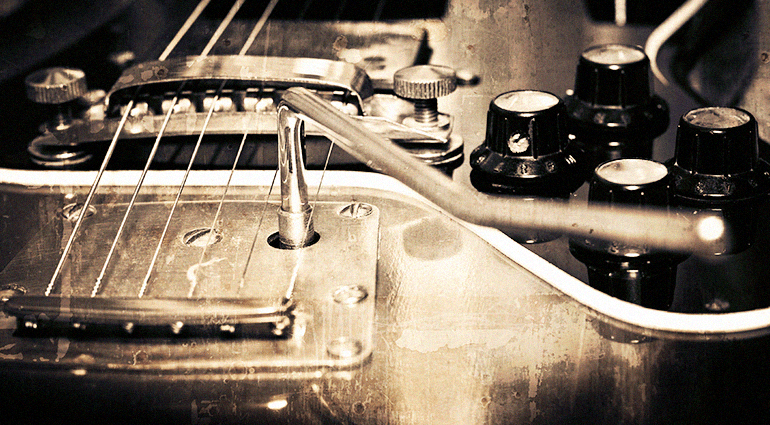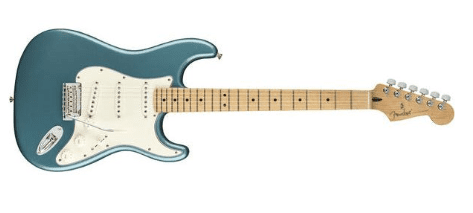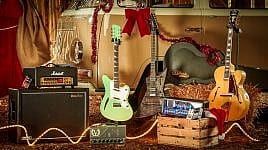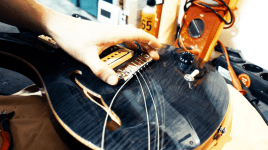
If we want to find and give an answer as to who invented the electric guitar , we always come back to the starting point where traditional competitors Leo Fender and Les Paul used the now legendary and still current models as blueprints for almost everything that was to come afterward manifested itself in the history of the instrument. But did they really invent the electric guitar? An attempt at a startling answer.
E-guitar: Not a flash of genius from a single invention
The invention of the electric guitar was not simply the result of a brilliant flash of inspiration. Rather, it was the quintessence of numerous previous discoveries and tinkering, which from our current perspective, after more than eight decades, are difficult to classify in detail. But this much is clear: We may well reconsider our general view of the era of the pioneers of the electric guitar.

Induction and electromagnetic pickups
The real heart of the electric guitar is the principle of induction as the physical basis for the functionality of the pickup . Electric guitars are equipped with one or more pickups. These pickups are usually a coil of copper wire wrapped around a magnet. If the strings vibrate near the pickup, an electromagnetic signal is generated in the copper wire due to induction. However, this is not an invention from the 1940s. But on the contrary…
Michael Faraday laid the foundation for the electric guitar in 1831
As early as 1820, the Danish physicist Hans Christian Ørsted noticed in an experiment that a magnetic needle close to an electrical conductor is deflected as soon as the current is switched on. The experiments were further developed by the French mathematician André Marie Ampère, the founder of electrodynamics, and in 1831 by the British naturalist and experimental physicist Michael Faraday – yes, that’s the one with the lightning bolt and the cage – with his discovery of electromagnetic induction. Without his definition of this electromagnetic induction, pickups in their current form would be unthinkable.
Martin’s groundbreaking development of the steel-string guitar
Christian Frederick Martin, on the other hand, never built an electric guitar , but the name is inextricably linked to the history of the electric guitar. His outstanding achievement was making his instruments playable with metal strings. The approach was not aimed at the development of the electric guitar, but without metal strings the induction-based pickup of the subsequent inventors would not have worked. Today, the company Martin founded still exists – Martin Guitars .

Sound transmission was based on phonographs, telephones, etc.
However, it must be said that the electrified instruments did not play a significant role even decades later. Rather, it was whole legions of hobbyists who dissected communication devices such as the phonograph, the radio or the telephone in order to create something new. Those who cared about the electrification of musical instruments were negligible. Rather, it was about the technical transmission of human communication, which the inventors were already experimenting with in their garages before 1900.

E-Guitar: They just wanted to show what electricity was capable of
In fact, it wasn’t musicians who had the idea of an electrified instrument. Rather, electric sound generation arose from a technical and playful idea. The first electric guitars didn’t arise from the musicians’ and inventors’ desire for more volume, better sound or optimized applications. It was about the fascination of electricity; the manufacturers wanted to show what cool things could be done with electricity. And that also included sound-generating induction and, as a result, the production of electromagnetic pickups. Mind you, we are still talking about the time before 1900. Neither Leo Fender nor Les Paul nor Orville Gibson were even born at that time.
Beauchamp’s first electric guitar had a turntable pickup
Sie sehen gerade einen Platzhalterinhalt von Standard. Um auf den eigentlichen Inhalt zuzugreifen, klicken Sie auf den Button unten. Bitte beachten Sie, dass dabei Daten an Drittanbieter weitergegeben werden.
Sie sehen gerade einen Platzhalterinhalt von Standard. Um auf den eigentlichen Inhalt zuzugreifen, klicken Sie auf den Button unten. Bitte beachten Sie, dass dabei Daten an Drittanbieter weitergegeben werden.
The number one source of music at the time was the gramophone, and that left plenty of scope for new applications. In 1926, the Dobyera brothers, in cooperation with the Texan George Beauchamp, tried to adapt the principle with which the shellac records were made to sound for a purely acoustic system. The metal guitar, the Dobro, was born. That was not enough for the resourceful Beauchamp though, he experimented with coils and magnets. He attached a record player’s pickup, which consisted of a coil and a permanent magnet, to a guitar. The actual first electric guitar saw the light of day, albeit little noticed. And they weren’t solid-body guitars yet.

The gold rush spirit reached musicians around 1930
The gold-digging spirit had now also reached instrument makers and musicians. Just two years later, the Stromberg Electro was announced, an electrically powered device that “produces an increase in volume”. From that point on, at the latest, it was all about volume and assertiveness. Despite the visionary development, Stromberg, the pioneer of a new era, disappeared from the face of the earth by 1930.
E-guitar: names that still resonate in today’s market
Other names followed, which are still extremely well-known today, such as the Ro-Rat-In Company in the 1930s, which later became Rickenbacker , or Lloyd Roar, who had been working on the development of his own reel pickup since the 1920s. The first electric guitar from Lloyd Roar’s company, Vivi-Tone, was built in 1932. The instrument was playable and could be purchased commercially. However, it did not catch on, and the pickup did not really correspond to the electromagnetic induction used today. The instrument sounded too thin.
Invention of the electric guitar: An outstanding achievement of garage pioneers
May this be understood correctly. The outstanding achievement of the instrument manufacturers was obviously to firstly optimize existing technology and secondly to build it into electric guitars . Around 1950, the Telecaster was the first Fender electric guitar to hit the market, followed a little later by the Stratocaster . In 1952 Gibson built the first solid-body guitar, the Les Paul, but at that time it was still equipped with P90 single-coil pickups. What should not be underestimated: Fender and Gibson were the first manufacturers who managed to make it into series production and were thus able to secure real cult status.
Feedback
We welcome feedback, questions, concerns, and suggestions in the comments!
7 comments
Leave a Reply
You are currently viewing a placeholder content from Facebook. To access the actual content, click the button below. Please note that doing so will share data with third-party providers.
More InformationYou are currently viewing a placeholder content from Instagram. To access the actual content, click the button below. Please note that doing so will share data with third-party providers.
More InformationYou are currently viewing a placeholder content from X. To access the actual content, click the button below. Please note that doing so will share data with third-party providers.
More Information







Henrik Myrbakken says:
Check out the Norwegian Nilsen-gitar:
http://norskegitarer.no/?page_id=558
I think it deserves a mention here.
Dave Johnson says:
No mention of Jim Burns who was fitting pickups to guitars in the 1940s.
Yngve Grønvik says:
I was going to say Nilsen too! Developed in 1947 and in shops by 1950 🙂
Barry Klarnett says:
The Rickenbacker Frying Pan is usually acknowledged as the first electric guitar 1931/32
patented in 1937.
Sean Rea says:
The frying pan is the worlds first real electric guitar and it had the only Patented pick up at the time
I don’t understand why it’s not above a telly or a Strat or a Less Paul as the original Guitar ?
Pippo Guarnera says:
To be precise, before the Telecaster, Fender had the Broadcaster on sale autumn of 1950, one year later Fender renamed to Telecaster for trademark conflict with Gretsch, which had a Broadkaster line of drums since 1935. There are also some (very rare) Fender known as “No-casters” produced during the model rename which were nameless.
Ian Alterman says:
It is worth noting that different guitars were “known” for different things. What Les Paul invented with the “log” – and later perfected – was the SUSTAINING solid body electric guitar. This differentiated it from Leo Fender’s guitars (as well as Rickenbacker and others), which did not have nearly the same note-sustaining capacity as the Gibson Les Paul.